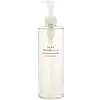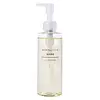Muji Jojoba oil Versus Muji Mild Oil Cleansing
What's inside
What's inside
 Key Ingredients
Key Ingredients

No key ingredients
 Benefits
Benefits

 Concerns
Concerns

No concerns
 Ingredients Side-by-side
Ingredients Side-by-side

Hydrogenated Polyisobutene
EmollientCoconut Oil Polyglyceryl-6 Esters
EmollientEthyl Oleate
EmollientSorbitan Oleate
EmulsifyingOlea Europaea Fruit Oil
MaskingSimmondsia Chinensis Seed Oil
EmollientHelianthus Annuus Seed Oil
EmollientDipropylene Glycol
HumectantCitrus Aurantium Amara Flower Water
MaskingPolyquaternium-51
Skin ConditioningPrunus Persica Leaf Extract
EmollientMalt Juice
Skin ConditioningSodium Hyaluronate
HumectantGlycerin
HumectantButylene Glycol
HumectantTocopherol
AntioxidantPhenoxyethanol
PreservativeMethylparaben
PreservativeHydrogenated Polyisobutene, Coconut Oil Polyglyceryl-6 Esters, Ethyl Oleate, Sorbitan Oleate, Olea Europaea Fruit Oil, Simmondsia Chinensis Seed Oil, Helianthus Annuus Seed Oil, Dipropylene Glycol, Citrus Aurantium Amara Flower Water, Polyquaternium-51, Prunus Persica Leaf Extract, Malt Juice, Sodium Hyaluronate, Glycerin, Butylene Glycol, Tocopherol, Phenoxyethanol, Methylparaben
 Reviews
Reviews

Ingredients Explained
These ingredients are found in both products.
Ingredients higher up in an ingredient list are typically present in a larger amount.
This oil comes from the seeds of the desert shrub called Jojoba. It is more commonly known as jojoba oil, a non-comedogenic oil.
Jojoba oil does not contain fragrance and has many fatty-acids, making it a great soothing ingredient.
It also contains Vitamin E, a great moisturizing ingredient. Vitamin E is also an antioxidant and protects your skin against oxidative damage.
This ingredient humectant properties, meaning it helps draw moisture from the air. This helps keep your skin hydrated.
While jojoba has antibacterial properties, it is only able to kill some strains of bacteria.
Studies also show it helps in wound healing. In fact, Indigenous cultures have used jojoba as a moisturizer and to help treat burns for centuries.
Fun fact: Jojoba oil similar to natural human skin sebum, so it has a great effect on dry skin. It is also promising with helping to regulate sebum production.
Due to its fatty acid content, Jojoba oil may not be fungal acne safe. We recommend speaking with a professional if you have any concerns.
Learn more about Simmondsia Chinensis Seed Oil